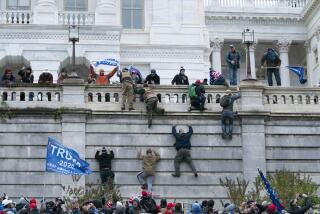Community Policing or Vigilantism? : Crime: Regulations would help people and police.
- Share via
Community policing in Los Angeles is beginning to take a strange twist. Citizens are not only helping cops but also becoming cops: enforcing their own laws, deciding who enters their neighborhoods and solving their own crimes. This bears a striking similarity to vigilante movements of the mid-1700s.
The main characteristics of a vigilante movement are regular organization and existence for a definite (though possibly short) period of time. There are an estimated 65 such organizations in Los Angeles, with memberships ranging from 25 to 500. These groups outnumber the LAPD and Sheriff’s Department by 5 to 1. Some wear uniforms, drive patrol cars and even carry weapons. The right of citizens to act as police is rarely questioned by courts and can be practiced by anybody. Unlike paid guard services, so-called citizen police are unregulated, unlicensed and untrained--yet under civilian laws, can make arrests, detain suspects and use deadly force to protect themselves or others.
Another characteristic of vigilante movements is that they are usually formed by community leaders, thus making them respectable. Two presidents (Andrew Jackson and Theodore Roosevelt), eight governors and four U.S. senators have either been vigilantes or expressed strong support for vigilante movements.
In Los Angeles, this is perhaps the most disturbing parallel, because most citizen groups acting as police are doing so under the control of community leaders within specific racial and ethnic boundaries. Korean merchants are patrolling after hours in Koreatown, as are members of the Jewish Orthodox community in the Beverly-Fairfax district. Although crime prevention is the primary intent, community isolationism in any form eventually breeds racism and ethnocentricity.
History tells us that vigilante movements became strong during the 1700s because of ineffective or nonexistent law enforcement and an uneven judicial system. Better than 90% of Los Angeles’ “community” police forces were founded and created during or immediately after the 1992 riots. Within many of the communities where citizen patrols now exist, crime victims typically call for assistance from the citizen police before they call 911. This is because, in many cases, citizen patrols respond faster and are perceived as more sympathetic and courteous.
When it comes to vigilantism, we know the warning signs and should treat the symptoms. But what is the cure?
* The first option is to address the cause: to restore faith in “the system.” Vigilante groups in the 1700s gradually faded away with the establishment of strong federal and state law-enforcement agencies and a court system that was perceived as fair. Lawmakers must develop guidelines, before the current situation get out of hand.
* The more viable option is for police to recognize and regulate the citizen-police organizations. Besides curbing the prospect of full-blown vigilantism, there could be an exchange of ideas, insights and talents from a partnership. While police forces are downsizing, the citizen-police movement in Los Angeles is expanding--without form, direction, supervision or even cultural sensitivity. Without effective planning by police and community leaders, we can only hope that our city’s version of “community policing” is not masking the early stages of a contemporary vigilante movement.
More to Read
Sign up for Essential California
The most important California stories and recommendations in your inbox every morning.
You may occasionally receive promotional content from the Los Angeles Times.













